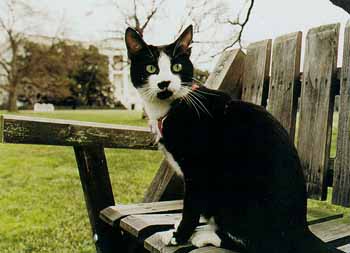Bicolor cat

A bicolor cat has white fur combined with fur of some other colour, for example black or tabby. There are various patterns of bicolor cat. These range from Van pattern (colour on the crown of the head and the tail only) through to solid colour with a throat locket. The tuxedo pattern is one of many possible bicolor patterns.
Where there is low-to-medium grade white spotting limited to the face, paws, throat and chest of an otherwise black cat, they are known in the United States as a tuxedo cat. High grade bicolor results in Van-pattern cats. There are many patterns between such as cap-and-saddle, mask-and-mantle and magpie (more randomly splashed). Bicolors are found in many breeds as well as being common in domestic longhair cats and domestic shorthair cats.
Solid color bicolor cats occur because there is a white spotting gene present along with a recessive allele of the agouti gene, which evens out the usual striped pattern of the colors of the coat. In contrast, tabby cats have an agouti gene that produces striping of the coat. The Abyssinian has agouti (ticked tabby) fur, giving the appearance of even colour with color-banded hairs.
White spotting can also occur with any of the tabby patterns, resulting in tabby-and-white bicolors. Colorpoint (Himalayan pattern) cats can have bicolor points although this variation is not recognised for exhibition. The body markings of bicolor colorpoints become clearer with age as the body fur of colorpoint cats darkens as the cats grow older and the white patches become more visible.
Grades 1 - 10 of bicolor in cats
There are 10 identifiable grades of bicolor in cats, plus several patterns with their own names. The cat labelled "bicolor" is the preferred pattern in show-quality bicolor purebred cats.

The gene involved is the variably expressed S (white spotting) gene.
- SS (two dominant alleles) results in high grades of white spotting (sometimes resulting in a solid white cat)
- Ss (one dominant, one recessive allele) results in medium grades of white spotting
- ss (two recessive alleles) results in low grades of white spotting (sometimes as little as a few white hairs)
Different bicolor patterns
A low grade spotting black-and-white bicolor cat is often known as a tuxedo cat or a Jellicle cat. To be considered a tuxedo cat, its black coloring should be solid through out, with white limited to the paws, belly, chest, throat, and possibly the chin. The tuxedo name is just that. It should appear as if the cat is wearing a tuxedo.
Another type of black-and-white bicolor cat is nicknamed "cow cat" or "moo cat" and includes the magpie, cap-and-saddle and mask-and-mantle patterns. A cow cat doesn't have the solid black "jacket" of the tuxedo cat. Instead, it has big black patches over a mostly white body, often with a black mask over the head. Some owners attribute chacteristics such as a love of water, big personalities and a playful nature to cow cats. "Black Mask Cats" are so called because they look like they are wearing a black mask over their head.
The Turkish Van (white and red) is one good example of a bicolor breed. Van pattern is known to animal geneticists as the Seychelles (Seychellois) Pattern and is classified into 3 variants:
- Seychellois Neuvieme - white with coloured tail and head splashes (classic Van Pattern)
- Seychellois Huitieme - white with coloured tail and head splashes plus additional splashes of colour on the legs
- Seychellois Septieme - white with splashes of colour on the legs and body in addition to those on the head and the coloured tail.
This is high grade white spotting of types 9, 8 and 7 on the bicolor chart above.
Tuxedo cats
A tuxedo cat is a bicolor cat with a white and black coat. Most tuxedo cats are also black mask cats, a common name for felines who, due to their facial coloration, look as if they are wearing a black mask over their eyes, and often over their entire head. To be considered a true tuxedo cat, the feline's coloring should consist of a solid black coat, with white fur limited to the paws, belly, chest, throat, and often the chin, although many tuxedo cats appear to sport goatees, due to the black coloration of their mandible -- that is, the lower jaw and chin. The derivation of the term tuxedo cat is self-explanatory, as the animal appears to be wearing the type of black tie formal wear commonly known in the United States and Canada as a tuxedo. In the United Kingdom, the tuxedo cat is sometimes known as the “Jellicle cat”, after the (fictional) tribe of black and white cats described by T.S. Eliot in Old Possum's Book of Practical Cats, which was first published in 1939.
See also
- Cat
- Domestic longhair cat
- Domestic shorthair cat
- Felidae
- Fictional cats
- Felix the Cat
- Sylvester the Cat
- Socks
Gallery of various pattern bicolors
-
Oscar Robles. A tuxedo cat that is part ragdoll.
-
A tuxedo cat
-
A bicolor Russian Blue
-
A ten days old bicolor kitten
-
An adult "cow cat"
-
An adolescent bicolor Cap-and-Saddle cat.
-
Vosot and Donut, two bicolors, take cat naps.
-
Beauty, a senior longhaired tuxedo cat.
-
Blip,an adult bicolour cat.
-
Pestie, a Tuxedo cat.
-
Ebony White Bicolor Oriental Shorthair Male
-
Blue and White Oriental Shorthair male
-
Turkish Van pattern






